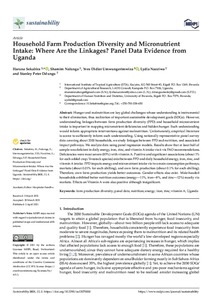| dc.contributor.author | Sekabira, H. |
| dc.contributor.author | Nalunga, S. |
| dc.contributor.author | Umwungerimwiza, Y.D. |
| dc.contributor.author | Nazziwa, L. |
| dc.contributor.author | Ddungu, S.P. |
| dc.date.accessioned | 2021-06-29T15:12:21Z |
| dc.date.available | 2021-06-29T15:12:21Z |
| dc.date.issued | 2021 |
| dc.identifier.citation | Sekabira, H., Nalunga, S., Umwungerimwiza, Y.D., Nazziwa, L. & Ddungu, S.P. (2021). Household farm production diversity and micronutrient intake: Where are the linkages? Panel data evidence from Uganda. Sustainability, 13(7), 4041: 1-21. |
| dc.identifier.issn | 2071-1050 |
| dc.identifier.uri | https://hdl.handle.net/20.500.12478/7150 |
| dc.description.abstract | Hunger and malnutrition are key global challenges whose understanding is instrumental to their elimination, thus realization of important sustainable development goals (SDGs). However, understanding linkages between farm production diversity (FPD) and household micronutrient intake is important in mapping micronutrient deficiencies and hidden hunger. Such understanding would inform appropriate interventions against malnutrition. Unfortunately, empirical literature is scarce to sufficiently inform such understanding. Using nationally representative panel survey data covering about 3300 households, we study linkages between FPD and nutrition, and associated impact pathways. We analyze data using panel regression models. Results show that at least half of sample was deficient in daily energy, iron, zinc, and vitamin A intake vis-à-vis FAO recommendations. Deficiencies were most severe (85%) with vitamin A. Positive and significant associations (about 1% for each added crop/livestock species) exist between FPD and daily household energy, iron, zinc, and vitamin A intake. FPD impacts energy and micronutrient intake via two main consumption pathways; markets (about 0.01% for each shilling), and own farm production (about 0.1% for each shilling). Therefore, own farm production yields better outcomes. Gender effects also exist. Male-headed households exhibited better nutrition outcomes (energy—11%, iron—8%, and zinc—12%) mostly via markets. Effects on Vitamin A were also positive although insignificant. |
| dc.description.sponsorship | African Economic Research Consortium |
| dc.format.extent | 1-21 |
| dc.language.iso | en |
| dc.subject | Farms |
| dc.subject | Production |
| dc.subject | Agrobiodiversity |
| dc.subject | Nutrition |
| dc.subject | Energy |
| dc.subject | Iron |
| dc.subject | Zinc |
| dc.subject | Vitamin A |
| dc.subject | Uganda |
| dc.title | Household farm production diversity and micronutrient intake: Where are the linkages? Panel data evidence from Uganda |
| dc.type | Journal Article |
| cg.contributor.affiliation | International Institute of Tropical Agriculture |
| cg.contributor.affiliation | LADS Consult, Uganda |
| cg.contributor.affiliation | University of Rwanda |
| cg.coverage.region | Africa |
| cg.coverage.region | East Africa |
| cg.coverage.country | Uganda |
| cg.coverage.hub | Central Africa Hub |
| cg.researchtheme | Social Science and Agribusiness |
| cg.identifier.bibtexciteid | SEKABIRA:2021 |
| cg.isijournal | ISI Journal |
| cg.authorship.types | CGIAR and developing country institute |
| cg.iitasubject | Agribusiness |
| cg.iitasubject | Agronomy |
| cg.iitasubject | Biodiversity |
| cg.iitasubject | Food Security |
| cg.iitasubject | Nutrition |
| cg.journal | Sustainability |
| cg.notes | Open Access Article; Published online: 02 Apr 2021 |
| cg.accessibilitystatus | Open Access |
| cg.reviewstatus | Peer Review |
| cg.usagerightslicense | Creative Commons Attribution 4.0 (CC BY 0.0) |
| cg.targetaudience | Scientists |
| cg.identifier.doi | https://dx.doi.org/10.3390/su13070000 |
| cg.futureupdate.required | No |
| cg.identifier.issue | 7: 4041 |
| cg.identifier.volume | 13 |
| cg.contributor.acknowledgements | We wish to express our deep appreciation to the African Economic Research Consortium (AERC) for the financial support to carry out this research under grant number RT17534. We are also grateful to the AERC resource persons, most notably Victor Okoruwa who was our focal
person, Damiano Manda who was managing Research at AERC, and members of AERC’s thematic Group E (Agriculture, Nutrition, Climate change and Natural resource management) for various comments and suggestions that helped improve this study from its inception to completion. We are also indebted to the anonymous referees who reviewed the paper and provided very useful comments and suggestions to enhance the overall quality of the paper. The findings made and opinions expressed in this paper are exclusively those of the authors. Authors are also solely responsible for content and any errors. |

